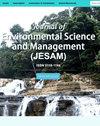Microbial Biofertilizers and Soil Amendments Enhanced Tree Growth and Survival in a Barren Mined-out Area in Marinduque, Philippines
IF 0.3
4区 环境科学与生态学
Q4 ENVIRONMENTAL SCIENCES
引用次数: 4
Abstract
A bioremediation protocol was developed for rehabilitating mine tailing areas using microbial biofertilizers and soil amendments. The effects on the growth and survival of tree species in a three-decade barren mined-out area in Barangay Capayang, Mogpog, Marinduque, Philippines were also determined. Three concurrent field experiments were established in June 2016 using Pterocarpus indicus, Acacia mangium and Eucalyptus urophylla. Treatments for this study were uninoculated seedlings and seedlings inoculated with mycorrhiza (MYKORICH® for P. indicus) or Surigao isolate (for A. mangium and E. urophylla) with and without nitrogen-fixing bacteria. Aseptically germinated seedlings were inoculated when they were transplanted from seed boxes into individual polybags. After six months, the seedlings were planted in the mined-out area following Randomized Complete Block Design. The excavated soil were mixed with 1 kg vermicompost and 500 g lime before backfilling the 30 cm3 planting hole. After one month, 10 g NPK fertilizer and 5 g urea were applied on each seedling. Microbial-inoculated seedlings showed better growth performance with higher plant dry weight and microbial population compared to the uninoculated plants after 27 months. Hence, P. indicus, A. mangium, and E. urophylla inoculated with arbuscular mycorrhizal fungi and applied with lime, vermicompost, and basal inorganic fertilizer could be effective as reforestation species in barren mined-out areas.微生物生物肥料和土壤改良剂增强了菲律宾Marinduque一个贫瘠采矿区的树木生长和存活
制定了一项利用微生物生物肥料和土壤改良剂修复尾矿区的生物修复方案。还确定了菲律宾Marinduque Mogpog Barangay Capayang一个30年贫瘠的采空区对树木生长和生存的影响。2016年6月,使用印度紫檀、芒果Acacia和尾叶桉进行了三项同时进行的田间试验。本研究的处理是未接种的幼苗和接种菌根(用于P.indicus的MYKORICH®)或Surigao分离物(用于A.mangium和E.urophylla)的幼苗,有和没有固氮菌。无菌发芽的幼苗从种子箱移植到单独的塑料袋中时进行接种。六个月后,按照随机完全区块设计将幼苗种植在采空区。在回填30 cm3种植孔之前,将挖出的土壤与1 kg蚯蚓堆肥和500 g石灰混合。一个月后,在每个幼苗上施用10g NPK肥料和5g尿素。与未接种的植物相比,接种微生物的幼苗在27个月后表现出更好的生长性能,具有更高的植物干重和微生物种群。因此,用丛枝菌根真菌接种并施用石灰、蚯蚓堆肥和基础无机肥的P.indicus、A.mangium和E.urophylla可以有效地作为贫瘠采空区的造林物种。
本文章由计算机程序翻译,如有差异,请以英文原文为准。
求助全文
约1分钟内获得全文
求助全文
来源期刊

Journal of Environmental Science and Management
ENVIRONMENTAL SCIENCES-
CiteScore
0.90
自引率
0.00%
发文量
10
审稿时长
2 months
期刊介绍:
The Journal of Environmental Science and Management (JESAM) is an international scientific journal produced semi-annually by the University of the Philippines Los Baños (UPLB).
JESAM gives particular premium to manuscript submissions that employ integrated methods resulting to analyses that provide new insights in environmental science, particularly in the areas of:
environmental planning and management;
protected areas development, planning, and management;
community-based resources management;
environmental chemistry and toxicology;
environmental restoration;
social theory and environment; and
environmental security and management.
 求助内容:
求助内容: 应助结果提醒方式:
应助结果提醒方式:


